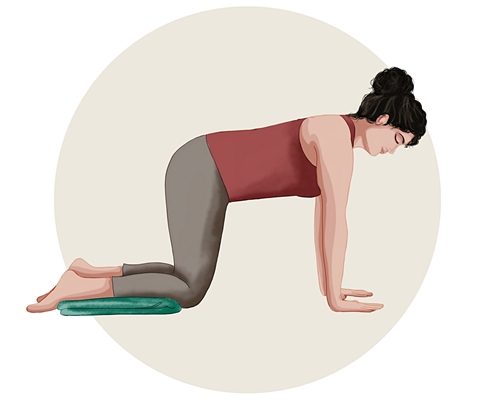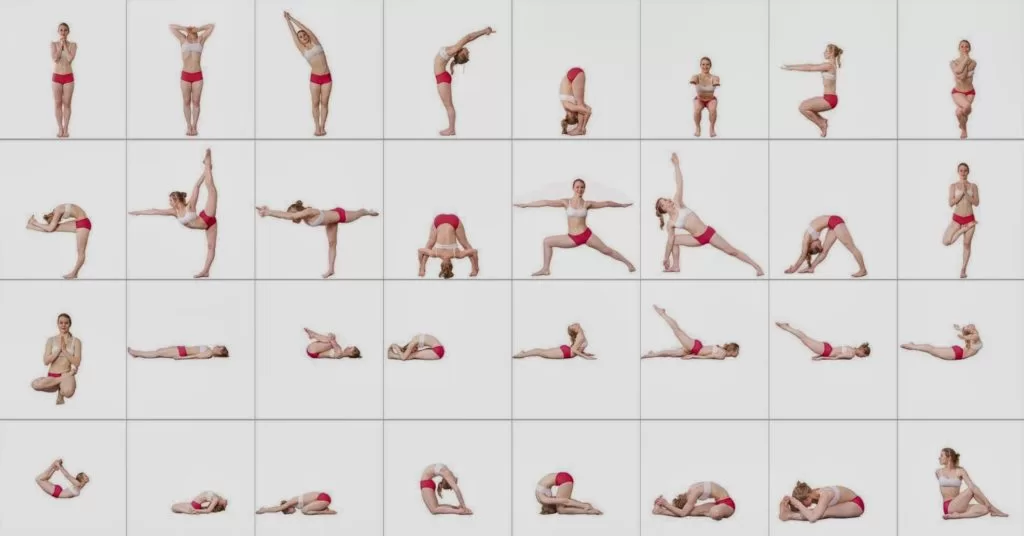
Why Do My Knees Hurt When Kneeling In Yoga?
Yoga is a practice that has been around for thousands of years and has gained popularity all over the world. It is known for its numerous benefits, including improved flexibility, strength, and overall physical and mental well-being. However, it is not uncommon for yogis to experience knee pain while performing certain poses, particularly those that require kneeling. If you are one of those who experience discomfort in your knees during yoga, you may be wondering why this is happening and what you can do about it.
In this article, we will explore the possible reasons for knee pain during yoga and provide some tips on how to alleviate it. Whether you are a seasoned yogi or a beginner, understanding the causes of your knee pain can help you modify your practice and prevent further injury. So, if you want to continue enjoying the benefits of yoga without the discomfort, read on to find out why your knees hurt when kneeling in yoga.

Why Do My Knees Hurt When Kneeling in Yoga?
Yoga is a wonderful practice that promotes physical and mental well-being, but it can also cause discomfort and pain if not done correctly. One common issue that many yogis face is knee pain when kneeling. This can be frustrating and discouraging, especially if you are new to yoga and trying to establish a regular practice. In this article, we will explore the reasons why your knees may hurt when kneeling in yoga and provide tips for preventing and managing knee pain.
Improper Alignment
One of the primary reasons why your knees may hurt when kneeling in yoga is due to improper alignment. When you are in a kneeling position, your weight should be evenly distributed between your knees and your shins. If your weight is too far forward or backward, it can put undue stress on your knee joints, causing pain and discomfort.
To prevent knee pain due to improper alignment, make sure you are sitting back on your heels and keeping your knees directly under your hips. You may also want to try using props, such as blocks or blankets, to support your knees and take some of the pressure off your joints.
Tight Muscles
Another common cause of knee pain in yoga is tight muscles. When your muscles are tight, they can pull on your knee joints, causing pain and discomfort. This is particularly true for the muscles in your hips and thighs, which can become tight from sitting for long periods of time, wearing high heels, or participating in activities that involve a lot of running or jumping.
To prevent knee pain due to tight muscles, make sure you are stretching regularly, particularly the muscles in your hips and thighs. You may also want to try using a foam roller or massage ball to release any knots or tension in your muscles.
Weak Muscles
In addition to tight muscles, weak muscles can also contribute to knee pain in yoga. When your muscles are weak, they cannot support your knee joints properly, leading to strain and discomfort. This is particularly true for the muscles in your thighs and glutes, which are important for stabilizing your knees and preventing injury.
To prevent knee pain due to weak muscles, make sure you are incorporating strength training exercises into your yoga practice. Squats, lunges, and other leg exercises can help to build strength in your thighs and glutes, which will in turn support your knee joints.
Overuse
Overuse is another common cause of knee pain in yoga. When you perform the same movements over and over again, it can lead to repetitive stress injuries, including knee pain. This is particularly true for poses that require you to put a lot of weight on your knees, such as hero pose or camel pose.
To prevent knee pain due to overuse, make sure you are varying your yoga practice and not doing the same poses every day. You may also want to try modifying certain poses to reduce the amount of weight on your knees.
Previous Injuries
If you have had a previous knee injury, you may be more susceptible to knee pain in yoga. Even minor injuries, such as a sprain or strain, can lead to long-term issues if not properly addressed. Scar tissue and inflammation can make your knee joint more vulnerable to pain and discomfort.
To prevent knee pain due to previous injuries, make sure you are taking the necessary time to properly heal and rehabilitate your knee before returning to your yoga practice. You may also want to work with a physical therapist or yoga instructor who can help you modify your practice to accommodate your injury.
Benefits of Yoga for Knee Pain
While knee pain can be a frustrating and discouraging issue, it’s important to remember that yoga can also be a powerful tool for managing and preventing knee pain. Regular yoga practice can help to improve flexibility, build strength, and reduce inflammation, all of which can contribute to healthier, happier knees.
To get the most benefit from your yoga practice, make sure you are working with a qualified instructor who can help you modify your practice to accommodate your needs. You may also want to consider incorporating other self-care practices, such as massage or acupuncture, to support your knee health.
Yoga vs. Other Forms of Exercise
When it comes to managing knee pain, yoga can be a great alternative to other forms of exercise that may be harder on your joints. Unlike running or jumping, which can put a lot of stress on your knees, yoga is a low-impact activity that can help to improve your overall joint health without exacerbating existing issues.
That being said, it’s important to listen to your body and not push yourself too hard. Even in yoga, certain poses may be more challenging or uncomfortable for your knees, and it’s okay to modify or skip them altogether.
Preventing Knee Pain in Yoga
To prevent knee pain in yoga, there are a few key things you can do. First, make sure you are practicing proper alignment and using props as needed to support your knees. Second, incorporate stretching and strength training exercises into your practice to improve flexibility and build muscle. Finally, vary your practice and modify poses as needed to prevent overuse and avoid exacerbating existing injuries.
By following these tips and listening to your body, you can enjoy all the benefits of yoga without the frustration and discomfort of knee pain. Remember, yoga is a journey, and it’s important to take things at your own pace and honor your body’s needs.
Frequently Asked Questions
Yoga is a popular form of exercise that involves various postures and movements. Kneeling is a common position in many yoga poses, but it can cause knee pain for some people. If you’re experiencing knee pain while kneeling in yoga, you may have some questions about why this is happening. Here are five questions and answers to help you understand why your knees may hurt during yoga.
Why do my knees hurt when kneeling in yoga?
Kneeling puts a lot of pressure on the knees, especially if you’re holding the position for an extended period of time. This pressure can cause discomfort and pain, particularly if you have weak or injured knees. Additionally, if you’re not using proper alignment or technique when kneeling, you may be putting even more strain on your knees.
To reduce knee pain when kneeling in yoga, try using a cushion or blanket to pad your knees. You can also modify the pose by using a block or other prop to reduce the amount of pressure on your knees. Make sure you’re using proper alignment and technique, and listen to your body if you feel any discomfort or pain.
Can knee pain in yoga be a sign of an injury?
Knee pain during yoga can be a sign of an injury, particularly if the pain is severe or persists after your practice. Common knee injuries include sprains, strains, and tendinitis. If you suspect that you have a knee injury, it’s important to see a doctor for diagnosis and treatment. Continuing to practice yoga with an untreated knee injury can exacerbate the problem and lead to further damage.
If you have a history of knee injuries or pain, it’s important to take extra precautions when practicing yoga. Talk to your teacher about modifications or alternative poses that can help you avoid further injury.
Are there specific yoga poses that can cause knee pain?
Certain yoga poses, such as hero pose (virasana), camel pose (ustrasana), and pigeon pose (eka pada rajakapotasana), can put a lot of pressure on the knees and cause discomfort or pain. However, knee pain can also occur in other poses, especially if you’re not using proper alignment or technique. If you’re experiencing knee pain during yoga, it’s important to pay attention to which poses are causing the pain and modify them as needed.
Remember that everyone’s body is different, and what works for one person may not work for another. Listen to your body and don’t push yourself too hard, especially if you’re experiencing pain or discomfort.
How can I prevent knee pain in yoga?
There are several things you can do to prevent knee pain in yoga. First, make sure you’re using proper alignment and technique in all of your poses. This means keeping your knees in line with your ankles, engaging your leg muscles, and avoiding hyperextension. It’s also important to warm up properly before practicing yoga, especially if you’re prone to knee pain.
Additionally, you can modify poses as needed to reduce the amount of pressure on your knees. For example, you can use a block or blanket under your knees in hero pose, or use a strap to support your leg in pigeon pose. Finally, consider wearing supportive shoes or knee braces during your practice if you have weak or injured knees.
When should I see a doctor for knee pain in yoga?
If you’re experiencing severe or persistent knee pain during yoga, it’s important to see a doctor for diagnosis and treatment. This is especially true if you have a history of knee injuries or pain, or if the pain is accompanied by swelling or instability. Your doctor can help you determine the cause of your knee pain and recommend appropriate treatment, such as physical therapy or medication.
In the meantime, be sure to take extra precautions during your yoga practice to avoid aggravating your knee pain. This may include modifying poses, using props, or taking breaks as needed. Remember that your health and well-being should always come first, even if it means taking a break from your yoga practice while you recover.
Knee Pain When Squatting Down or Kneeling (Do This!)
As a professional writer, it is important to understand the mechanics of our own bodies so that we can avoid injury and pain. When it comes to kneeling in yoga, it is not uncommon for many people to experience discomfort in their knees. This can be caused by a number of factors, including poor alignment, muscle imbalances, and underlying conditions such as arthritis.
In order to prevent knee pain when kneeling in yoga, it is important to focus on proper alignment and engage the muscles of the legs and core to support the knees. It may also be helpful to incorporate exercises that strengthen the muscles around the knee joint and to use props such as blankets or blocks for added support. By taking these steps, we can continue to enjoy the benefits of yoga without experiencing unnecessary pain or discomfort in our knees.

